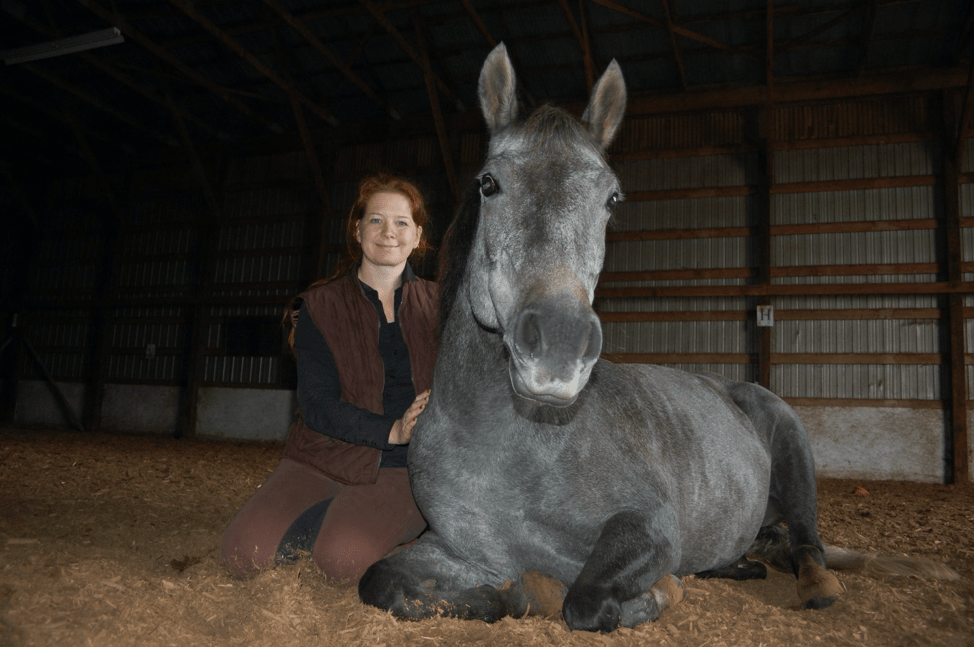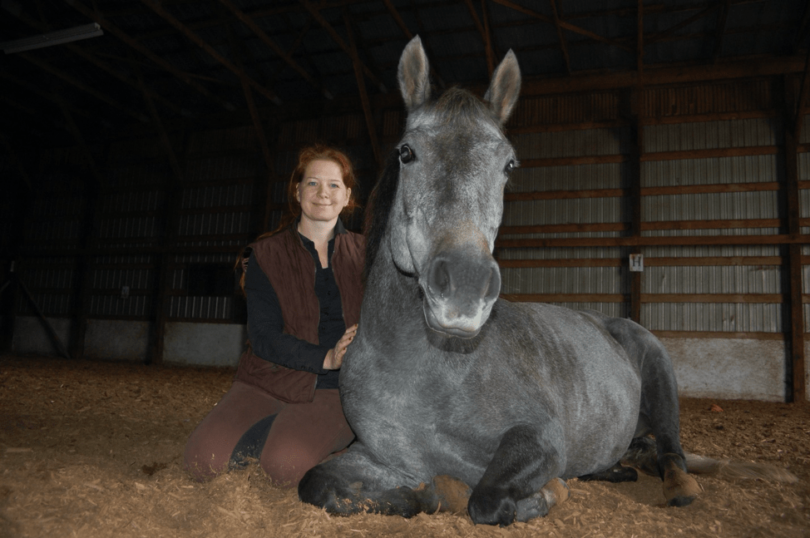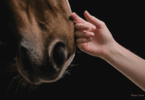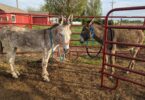Follow this easy clicker training plan so your horse lies down without ropes or force.
Clicker training is a training method that uses positive reinforcement. The ‘positive’ means, in scientific terms, that something is added to strengthen behaviour. The ‘something’ is, in this case, a treat. Your horse will quickly associate his behaviour with your click that is always followed by a treat.
In order to provide clarity to the horse, we use the click of a box clicker to mark the desired behaviour.
The click also gives us, as trainers, time to get a treat out of our pocket and give it to our horse. The sooner the reinforcer (treat) is followed or even been given during the desired behaviour the sooner your horse connects the dots.
We use a ‘bridge,’ the click, to close the time gap between the horse’s desired behaviour and the delivery of our reinforcer (giving the treat).
Lying down is a difficult behaviour to train because there needs to be a certain amount of trust between trainer and horse. It also helps if you use high value reinforcers — like extra yummy horse treats — to train this behaviour.
Chief Rookie Aside: All the horses at my barn are obsessed with The German Horse Muffin treats. They only get them on special occasions.
In this article, I tell you how to train your horse to lie down without ropes or force — step by step.
Read more about this topic in my article about 6 Easy Clicker Training Exercises for Horses.
5 Ways of Training Behaviour in Clicker Training
With positive reinforcement, you can use 5 different techniques to train behaviour. These 5 methods all have pros and cons, which I have written about in my blog.
Here’s a quick summary:
- Luring: Use a lure to help coax the horse into a behaviour with a treat.
- Molding: Sometimes referred to as ‘manipulation,’ this is physically guiding or otherwise coercing a horse, or one body part, into the behaviour you want to teach.
- Targeting: Touch a specified surface (e.g. a target stick) with a particular body part.
- Shaping: Goal behaviour is achieved by splitting the desired behaviour into many tiny steps and training each step separately (clicked and reinforced).
- Capturing: ‘Catch’ the end behaviour as it happens and reinforcing it with a click and treat.
In order to teach your horse to lie down, luring isn’t the best method.
Experienced trainers can use molding and ropes to lift the horse’s legs in order to let them kneel and then lie down. Note: This method can be very dangerous, and I don’t recommend it.
It takes great expertise to do it right and not just force the horse to lie down by pulling a leg away so he gets down. This isn’t a friendly technique, and it will not help build trust!
In order to use targeting skillfully in lying down, you could teach a horse to target his sternum so he will bring it to the ground eventually. Then you could target the legs separately in order to bend them in the way they usually lie down. Not practical either!
That leaves two techniques that can successfully help teach your horse to lie down with clicker training: shaping and capturing.
How do you teach your horse to lie down on command?
What you’ll need:
- Clicker (you can get an inexpensive one on Amazon)
- High-value treats like carrots or something else your horse really values
- A place where your horse is likely to lie down (soft surface like a sandy spot in the pasture or the arena)
Why teach it:
It’s a way of measuring the amount of trust you’ve built and a fun way to test your skills as horse trainer.
How to do it:
In my online trick training webinar Teach Your Horse to Lie Down, I go into detail how you can use shaping and capturing successfully to teach your horse to lie down.
For now, let’s focus on capturing the behaviour.
Prerequisites:
Your horse needs to know what the ‘click’ means. Read my article about easy slicker training exercises for horses to learn how you teach your horse the HippoLogic Key Lessons, your keys to success in horse training.
You also need to learn as much as you can about your horse’s behaviour and his habits.
How to train it:
In order to capture this behaviour, you need to be ready with your clicker and treats so that you can let your horse know right away what you want to see more of: lying down.
Prepare to capture the behaviour when he’s kneeling down to take a roll–usually after a ride or a bath. You need to be ready to click and treat his as soon as he’s lying down.
Wait until he’s on the ground so that he won’t jump up again as soon as you click and looks at you like, ‘Where is my treat?”
Another great strategy is to wait until your horse lies down to sleep. Some horses lie down for a nap right after breakfast, while others prefer a siesta in the middle of day.
- If you keep your horse at home, you probably know that he lies down at night and you can enter his stall and give him treats.
- If you board your horse, ask the staff about the habits of your horse.
If you know when your horse sleeps, try to be at the barn at those times to capture the desired behaviour.
Once you have captured this behaviour with a click and lots of treats, you’ll notice he will be more and more eager to lie down.
Then it’s time to put a cue to the behaviour.
You can say “Down.” If he wants to lie down or have a roll without you giving the verbal cue you can either give the cue quickly so he can be successfully earn a click and treat or you can ask a simple behaviour to distract him from lying down.
You want this behaviour on cue!
You can also teach your horse to come when called with clicker training.
Training Tips for Success
- Make sure you give the horse a “jackpot” after you click: keep feeding him treats and be generous. You might have time for 1 treat or multiple. If you keep feeding for as long as he lies down he will do it again next time.
- Don’t over ask. If your horse lies down once, that’s good enough for today.
- Practice regularly in the beginning, but don’t over train. I recommend three or four days in a row, then let it go for two days. This will give your horse’s brain the chance to make neural pathways (i.e. latent learning). The brain is making a backup of the learned behaviour, and you will most likely get better quality results after a two-day break. Think of how refreshed you are after a weekend off!
- Once he offers the behaviour more often when you’re around, it’s time to put a verbal cue on the behaviour.
- Start teaching lying down in summer when it’s hot or in winter when it’s been snowing. Horses love to roll in the snow, and this will be a perfect opportunity to click and treat him for lying down.
- Bend over to feed treats, or squat so you can stand up quickly (if needed).
- Squat next to him, never right in front of the horse. When horses stand up they put their front legs up first and you don’t want to be in the way!
- Always squat down to the side where his back is, not where his legs are (see photo).

Where to Learn More
Join HippoLogic’s Trick Training Webinar Teach Your Horse to Lie Down to learn even more about how to train this behaviour.
About Sandra Poppema
Sandra Poppema, BSc, started her career as a riding instructor 30+ years ago. She noticed many riders needed to improve their communication skills. She became a horse trainer and began teaching equestrians how they could improve their relationships with their horses through intentional training and riding. Sandra became the go-to person for online positive reinforcement training after taming and training a wild horse with her innovative HippoLogic Key Lessons. She created this home-study program so horse people around the world can become autonomous equine clicker trainers.
Learn more on the HippoLogic Horse Training website, and request your free 5-Step Clicker Training Plan!
P.S. Enjoy this article? Trot on over to:
- 6 Easy Clicker Training Exercises for Horses (With Pictures)
- Teach Your Horse to Come When Called
- Friendly & Fun: 4 Best Horse Breeds for Beginners
- Keep Calm & Ride On: Meet the 3 Calmest Horse Breeds
- 3 Riders on Equestrian Bullying (And What to Do About It)
- 32 Things You Can Do Now to Calm Your Riding Nerves Forever








